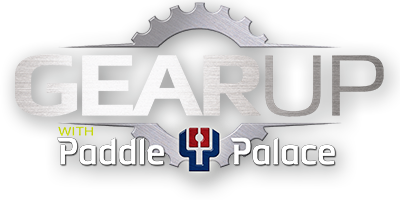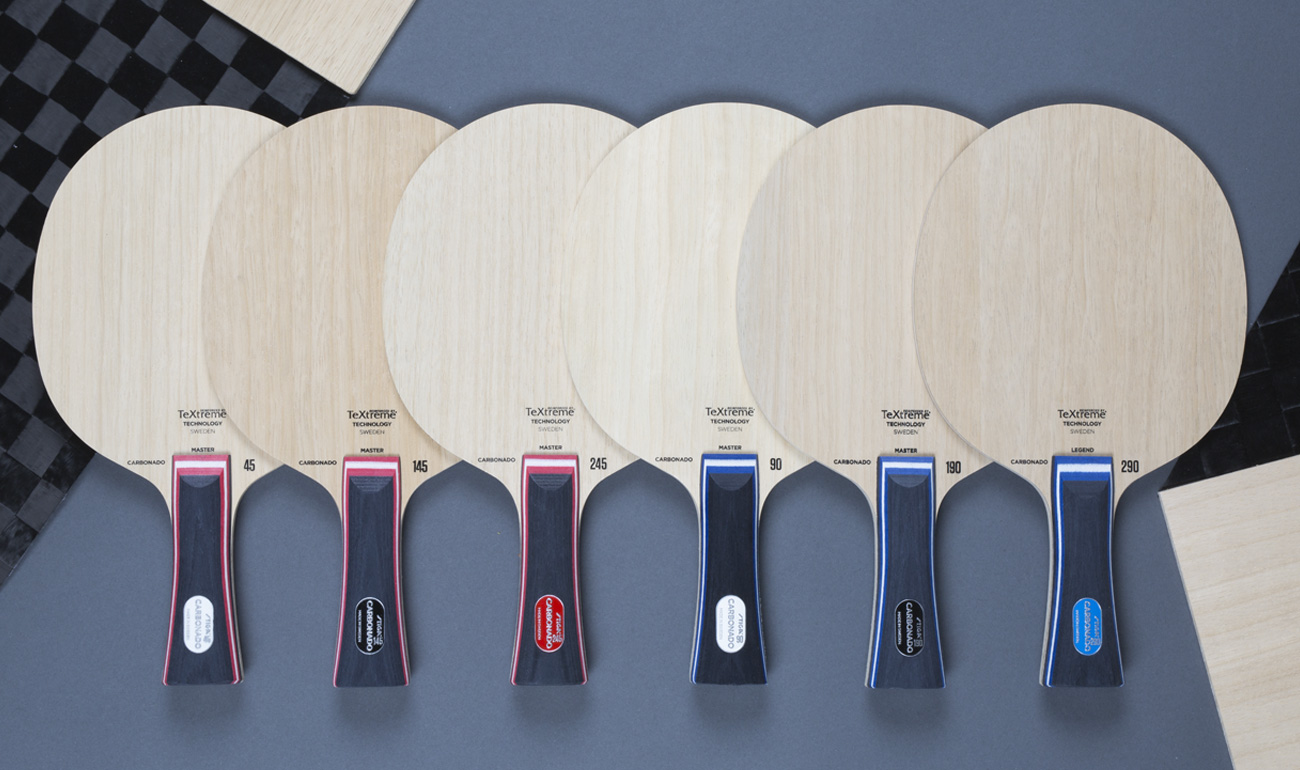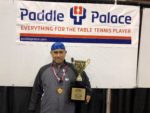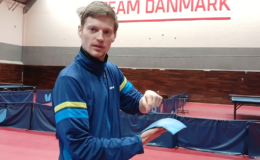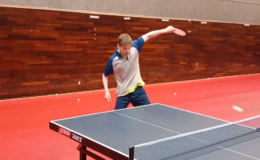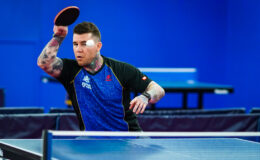Thank you to the experts at Stiga, Tibhar, Donic, Nittaku, Andro, and Yasaka for answers to Frequently Asked Questions about table tennis blades.
1) How does blade weight affect performance? Why would a player prefer a light or heavy blade?
ANDRO: Weight is of course one of the most important blade criteria. Each player has a different opinion on this topic. Some want a light weight because they believe their arm will not get tired or they have the feeling they can react faster. Players who like a heavy weight think that they can transfer more energy and momentum to the ball and as a result have more efficient shots.
STIGA: With a heavier blade you often get more powerful strokes but it also affects your reaction time. I know many players who hunt for an exact weight for their blade, but they often overlook factors like the weight of rubbers and glue. The total weight is what’s important, and the best weight for a player is very individual.
NITTAKU: In general, heavy weight blades give more power to the ball. Light weight blades make it easier to switch from forehand to backhand. Top players tend to select blades from 85-89 grams.
DONIC: Lower class players (hobby class) prefer light blades whereas higher class players (pro) prefer heavier weight. One reason could be the improved technical skills of topspin oriented players.
YASAKA: Generally, with all other factors being equal, a heavy blade is faster than a light blade. Most top players prefer a little bit heavier blade, while amateurs often want lighter weight blades.
TIBHAR: The heavier the blade, the more powerful it gets. Blades with the same composition can have different weights. Heavy blades = faster, lighter versions = better control. However, weight differences have no impact on the basic characteristics of the blade. Some players prefer a specific ply composition, but they search for a light model because they use hard and thick rubbers which are heavier than soft rubbers. Other players choose a heavy blade among their favorite model in order to have a more powerful blade. Keep in mind that technique and strokes cannot be applied properly if the blade/rubber combination is too heavy.
2) What is the difference between all-wood and composite blades? How do carbon layers affect blade performance, and why would a player prefer an all-wood or composite blade?
YASAKA: A composite blade has a combination of wood veneers and other material, often carbon fiber. The rules say that there must be at least 85% by weight of wooden material. The carbon layers make the blade stiffer, giving more speed and a bigger sweet spot. Some players prefer all-wood blades because they feel the ball better and have better control. However, there are many different carbon material and constructions, and some “carbon blades” have quite good ball feel. There are also some pure wood blades that are very fast.
STIGA: An allwood blade has a focus on control and is very good for “safe” players or developing players. When using a composite blade you need to have good skills to be able to use all that the blade offers. In general, players use blades that are too fast. Many players think table tennis is just about speed, but then they forget about spin and placement. To win a point you “only” need to put the ball on table one more time than your opponent!
NITTAKU: In general, when the plies are all-wood the touch is softer and the speed is slower while a blade with carbon will have increased speed, a harder feeling, and more stability in the sweet spot. Which to choose depends on the taste and playing style of the player. All-wood blades release the ball more slowly so even though a player’s swing speed is slow, it will be easier to create spin. With a carbon blade the releasing of the ball is faster but a player with a fast swing can still make spin.
DONIC: Carbon layers ensure higher stiffness and an enhanced sweet spot which means better control and penetrating power.
ANDRO: The addition of composite material brings hardness, rigidity and consistency to the blade. It provides more speed. On the other hand the player will not feel the ball coming into the racket as much as with an all-wood blade. It could also be that the player will lose a bit of control.
TIBHAR: The player’s hand gets more sensation and feedback with an all-wood blade. An all-wood blade creates a bigger curve and is the perfect tool for topspin strokes. Composite blades make the blade more stable. Disturbing vibrations resulting from the ball/bat contact have here disappeared. The optimal sweet spot of composite blades is bigger. The blade is also faster – the ball/bat contact time of such blades is shorter than with “all-wood” blades.
3) What does it mean when a blade is “fast” or “offensive”? How does this affect play?
DONIC: A fast or offensive blade has higher pitch, is more stiff, and the contact time is short.
NITTAKU: “Fast” simply means the speed is fast. “Offensive” is aggressive (offensive).
ANDRO: With a fast blade the ball touching momentum is shorter. The blade is harder and the ball directly leaves the racket. This brings more speed, more power, but also less control.
YASAKA: Basically the fast / offensive blade give you more speed in your game.
TIBHAR: It is subjective. The ball/bat contact time is shorter. Hence, controlled strokes such as block serve or return games are more difficult to control. Offensive strokes and play at a further distance from the table need less effort and are more difficult for the adversary to counter.
STIGA: A fast or offensive blade often has 5, 7 or 5+2 layers. If using 5 ply then there are at least 2 layers that are stiff or harder in some way. A player that uses this kinds of blade shall normally have a certain skill in order to achieve performance potential that the blade offers.
4) What does it mean when a blade is “slow” or “defensive”? How does this affect play?
DONIC: A slow or defensive blade has lower pitch, it is more flexible with bigger vibration, and the contact time is longer.
STIGA: A slow blade is made with soft woods and often with thinner layers of plies. These “slow” blades focus on control and are more “forgiving” when playing difficult strokes. The player needs to rely on spin and placement of the ball and not so much on speed.
ANDRO: With this blade, the player has the feeling that the ball comes into the racket and stays longer. This brings a good feeling and more control.
YASAKA: Basically the slow / defensive blade gives your game more control.
TIBHAR: This is the reverse answer of question 3. The ball/bat contact time is longer. The strokes and the ball are easier to control. Defensive blades sometimes absorb the resulting speed/energy. Offensive bats request more effort or technical adjustment. The strokes of the adversary are much easier to counter/return.
5) How does the number of wood layers (plies) affect play?
ANDRO: It is just a question of feeling. But what we can say is if we speak about the same wood on two rackets, the racket that consists of more plies will be heavier, more stable and consistent and also probably faster.
STIGA: It is best is to have an odd number of plies because then you can protect the blade from warping. If even numbers are used, one side can become stronger and then it’s very easy for a blade to curve. The total number of plies doesn’t matter but 5 ply blades are most common at this time, and better players tend to use 7 ply wood blades or 5+2 blades, (5 ply of wood and 2 layers of fiber material). The only thing that normally affects your blade in terms of number of plies is the weight.
DONIC: It depends which plywood (soft or hard) is used and which composition the blade is produced
NITTAKU: There are difference in what the material and the thickness though, in general a blade with many plies are heavier and powerful.
YASAKA: Basically a bigger number of veneers give a faster blade. However, the blade gluing method also affects the speed and ball feel.
TIBHAR: Generally speaking, the quantity of the layers (plies) affects the speed of the blade: more plies = faster, less plies = slower. However, 5-ply blades can sometimes be faster than 7-ply blades. It depends on the player’s own appreciation and preference.
6) How does the thickness of plies affect blade performance?
STIGA: First, it affects the weight of a blade, it becomes heavier or lighter depending on whether the plies are thicker or thinner. Then of course it comes to the combination of plies and it’s not always that the more plies you have the faster the blade will be, for example look at the fast one ply Hinoki wood blades that are on the market. The tricky part for production is always to find out the different thickness of each ply, to combine together and then to be a good blade for the category.
NITTAKU: In general, when the ply is thicker the flexibility will be less and there will be more speed, and if the ply is thinner the flexibility will be more and with less speed. Of course, there are many other differences depending on the type of material.
TIBHAR: Usually in a blade composition, the core plies are the thickest. The outer plies are relatively thin and their thickness depends on the wood essence. A blade is composed of a combination of harder and softer plies; these plies are inherent to the playing characteristics of the blade. Blades with thicker plies are usually more massive/powerful.
7) When, and how often, should a player change their blade?
DONIC: Nowadays with water based glue, players are changing their blade frequently because it becomes softer over time from the liquid of the glue. Additionally, hand perspiration makes the plywood softer and respectively fractural.
STIGA: It’s of course up to the player, but what a player should keep in mind is that blades change and get softer over time. When a player changes to a new blade of the same model they often say, “Have you changed the composition of the blade? It does not feel the same as the one I had before”. The player does not realize the following factors that have altered the original characteristics: 1. How long they have used the blade, 2. Re-gluing many times, causing the water based glue to slowly affect the hardness of the wood since wood and water are not the best combination, 3. Over long periods of time, often the blade develops very small cracks between the wood layers, often hard to see, which affect the blade a lot. The small cracks destroy the tension between the layers and it means loss of speed. Most of the Chinese top players change their blades around every 4-6 months. Why? They do it in order to make sure that they always have the same “new” blade feeling and to not get a surprise when they change their blade.
ANDRO: When the technique or the level of the player has developed. A blade that fits the player´s technique or level a few months ago is not necessarily the “good one” if the player has improved. Some players like to keep their blades for months or years and some like to change often. This is a very personal matter, but players shouldn´t forget that wood is a natural product and can get tired, so it is preferable not to wait too long.
NITTAKU: This depends on the player. Some won’t change it for several years, some change it often.
YASAKA: A carbon blade has to be changed more often than a pure wooden blade. The carbon material “gets tired” over time, and the blade loses some speed characteristic.
TIBHAR: This is up to the player’s appreciation. The playing characteristics of the blade change with time passing and usage. The blade accumulates humidity (sweat) which changes the blade and makes it softer. Synthetic fibers (Carbon etc.) may breach after a long utilization or may not produce the desired stability and power effects anymore.
8) Do you recommend adding varnish or lacquer to seal the blade? Why? How often? Does this affect the playing characteristics of the blade?
STIGA: It’s not a bad thing to add varnish to a surface, but the player needs to be careful not to put on too many layers. Too much varnish changes the characteristics of the blade by making the surface harder. In adding varnish I always recommend just one layer. One layer does not affect the blade but will sink down and combine and strengthen the wood.
DONIC: Most blades are factory sealed already. For players who change their rubbers frequently it is recommended to use sealer which has no impact on the blade characteristics.
ANDRO: Varnish will protect the blade when removing the rubbers, so for this reason it can be good to do it. It is not necessary to do it often. Normally 2 or 3 layers before the first use should be sufficient.
YASAKA: In our factory we varnish most of the blades. It does not affect the playing characteristics so much (in theory it’s a little bit faster) but it protects the outer veneers when changing the rubbers.
TIBHAR: We recommend adding a thin layer of lacquer in order to seal the blade, because the glues currently on the market are aggressive for the blade, and when you change your rubber it can happen that you remove a little bit of the wood fibers of the outer plies of the blade. Too much lacquer makes the blade harder and changes its characteristics.
9) What does the sound of a blade tell us? (Higher pitch vs. Lower pitch)
DONIC: Higher pitch = fast, and lower pitch = slow
NITTAKU: Higher pitch = hard feeling, and lower pitch = soft feeling.
TIBHAR: Higher pitchmeans faster and harder, lower pitch means slower with more control.
STIGA: A high pitch is a stiff blade and in most cases a fast blade. If you listen to a blade with carbon inside, you will hear a very high pitch. A low pitch in most cases is a bit slower blade compared to a high pitch. Also when you hear a low pitch there is often mainly softer wood in the blade.
YASAKA: Basically a higher pitch tells that the blade is faster than a lower pitch. However, this is not always true. For example, a “balsa blade” can have a high pitch and in some play feels fast, but when hitting very hard the blade is not so fast. (Top players very seldom use ”balsa blades”.)
ANDRO: A higher pitch is normally connected to a faster blade and vice versa.
10) In what way does the change to the new ABS ball affect what a player should choose for a blade? What type of blade works best with the new ABS balls?
STIGA: It’s very difficult to say that a certain blade works best for the ABS ball since it’s always individual to the player and their technique. In general players are changing to stiffer and faster blades. This is based on the general feeling that the ABS ball is slower and has less spin rotation.
ANDRO: As everybody knows now, the ABS balls are slowing down the game. A player needs more power to deliver good strokes. That´s why, in general, players should choose a faster blade compared to the times of the celluloid balls.
TIBHAR: With the change to the new balls, strokes lose on penetration force, length and spin. The adversary has better control over the balls and it is easier for him to play an active game. Players can try to counter this by using faster and more aggressive blades.
DONIC: Most of the top players changed from all wood blades to composite blades because of the changed playing conditions with the plastic ball and higher expenditure of energy or less speed.
NITTAKU: We see that there are more changes from outer carbon to inner carbon or from a carbon blade to a wooden ply blade among the players. Mostly any change is due to the individual taste of the player.
11) What are the different kinds of wood used in making table tennis blades? How does the various wood affect the performance of the blade? (can you be specific in naming woods?)
STIGA: There are many various kinds of woods that different manufacturers use. I think the majority of blades produced have abachi or kiri inside in combination with other wood types. We have for example our Ebenholz blades where we use Ebenholz as an outer ply. Ebenholz is a very hard wood and that gives a very special characteristic to the blade. It’s suitable for players who don’t depend on a high arc on the ball. Then we also also use Rosewood. It’s also very hard but not as hard as Ebenholz. The Rosewood blades allow a higher arc on the ball.
YASAKA: In our factory we use many different kinds of wood, with different characteristics (weight, hardness, toughness, appearance) and also different thicknesses. Examples are: abachi/ayous, limba, koto, different kind of pine, walnut, wenge, santos, anegre, balsa. Outer veneers of walnut give a faster blade than limba if the construction and thickness are the same.
TIBHAR: Trying to determine the performance of a blade purely based on the wood essence is actually not possible. There are too many different possibilities. The combination of different wood essences, the art of gluing, and the ply selection all play a determining role in the performance of the blade. Following are some overall examples:
Balsa = light, used mostly in the heart of the layers
Ayous = soft and fast
Limba = hard layer, used mostly as an outer ply
Koto = harder layer
Kiri = soft, light, used mostly in the heart of the layers.
DONIC: Harder plywood makes the blade harder and faster, softer plywood makes the blade softer and slower.
NITTAKU: Kiso hinoki, Limba, Ayous, Paulownia wood, Wenge, Walnut are common table tennis woods we use. The effect of these woods varies due to the type of the wood, thickness, and mixture, and precise info is a corporate secret.
12) What type of blade should a player use with smooth rubber, vs pips or long pips rubber?
STIGA: That is a tricky question. I would recommend a softer blade so the player can feel that he can get the extra advantage of the long pimples. If using a too hard blade the long pimple rubber can become rather fast and difficult to control and in general players using long pimple rubbers have focus on control and play smart, that why I think a blade with softer wood and good control.
NITTAKU: It is hard to specify which blade to use for a smooth rubber. For example for a Speed Aggressive Play we will recommend the Acoustic Carbon and for a Good Balance for Offensive and Defense with both hand rally we recommend the Latika.
TIBHAR: There exists no patented prescription per say. The player’s potential to estimate the special playing characteristics of the player’s material or the rotation reversal is determinative. However, since in most of the cases we speak about a game DEF/OFF, we would recommend offensive blades.
13) What is new in the area of blade technology? What trends do you see in the future?
YASAKA: The trend over many years is that more players are using composite blades. There might be new carbon material available and gluing methods might develop.
DONIC: Possibly we will see blades made of 100% Carbon or other fiber materials.
TIBHAR: We are currently focusing on developing rubbers with better penetration strength in order to put the adversary under pressure. When we look at the future, we think about introducing new blade materials.
STIGA: The trend we see as I have mentioned above on the ABS ball question is players tending to use faster and stiffer blades and an increased use of fiber blades. In terms of new technologies we always have something going on but the testing process takes time to make sure the outcome will be as expected. But for the autumn 2019 we will have something new and exciting coming out.
NITTAKU: We are continuously doing research and the actual technology will be a secret. Most new developments are driven by changes in the rules and evolution in playing style.
TIBHAR: We are currently focusing on developing rubbers that have better penetration strength in order to put the adversary under pressure and avoid that non-dangerous services turn in favor of the adversary. If we look at the future, we think about introducing new blade materials.
